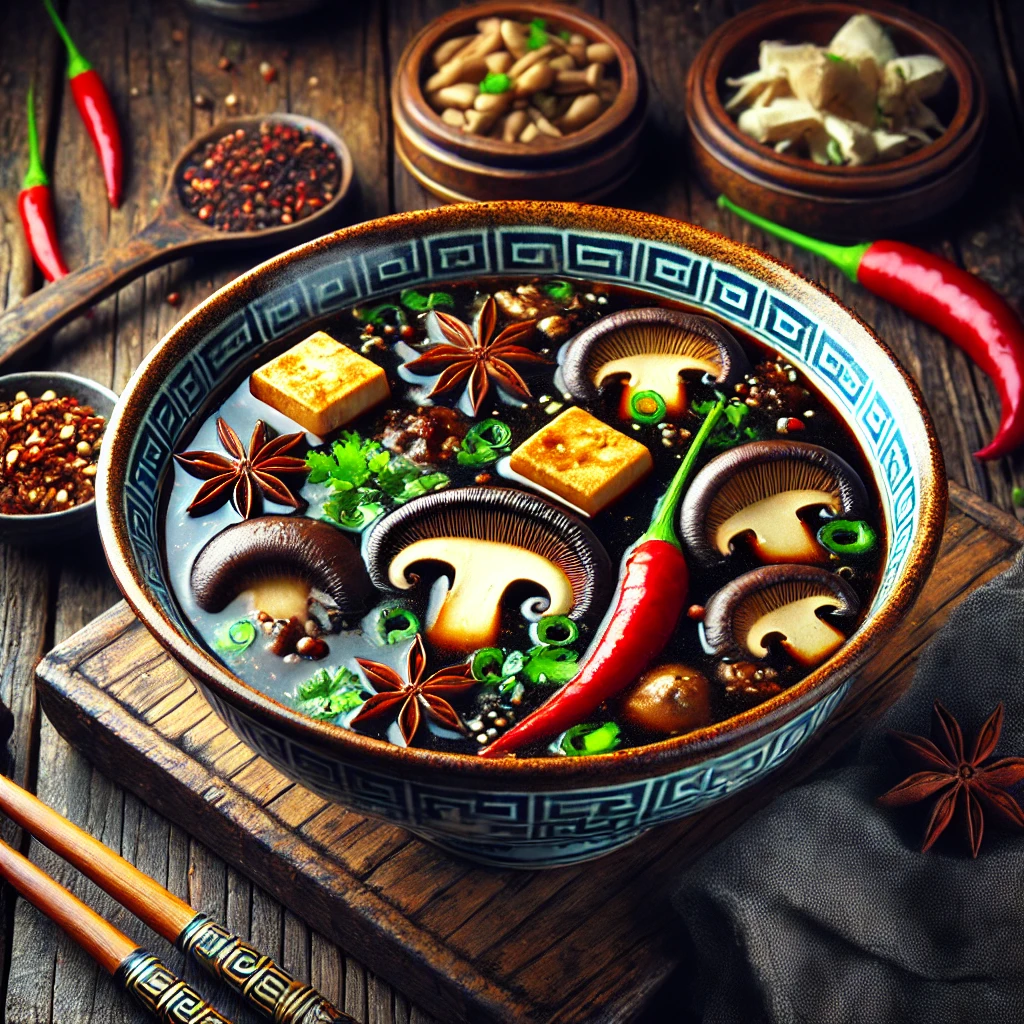When you enjoy a bowl of hot and sour soup, you may notice some dark, mysterious ingredients. These black elements not only add a chewy texture but also enhance the earthy flavor of this popular Chinese dish. So, what exactly is the “black stuff” in hot and sour soup? In this article, we’ll explore the common black ingredients, how they’re prepared, and the role they play in creating the dish’s distinct flavor.
The Main Black Ingredients in Hot and Sour Soup
The black ingredients in hot and sour soup typically consist of different varieties of mushrooms and fungus, each offering unique textures and flavors.
Wood Ear Mushrooms (Black Fungus)
One of the most common ingredients is wood ear mushrooms, also known as black fungus. These thin, dark mushrooms are prized for their chewy texture and subtle taste. Often sold dried, they need to be rehydrated before being added to the soup.
To see how wood ear mushrooms fit into an authentic recipe, check out our detailed guide on hot and sour soup recipe, which walks you through the steps of making this traditional soup at home.
Shiitake Mushrooms
Shiitake mushrooms are another dark ingredient frequently found in the soup. These mushrooms have a rich umami flavor, especially when dried and rehydrated. The darker variety of shiitakes adds a deeper, earthier note to the broth, complementing the spicy and sour elements of the dish.
For a broader exploration of ingredients in hot and sour soup, see our comprehensive article on the key ingredients in hot and sour soup, which breaks down each component in detail.
Other Dark Ingredients in Hot and Sour Soup
Beyond mushrooms, other dark or black ingredients are sometimes used to bring even more complexity to the dish.
- Black Moss (Fat Choy):
This edible algae, also known as fat choy, appears as fine, black strands that resemble hair. It’s particularly popular in Chinese New Year dishes and adds an interesting texture to soups. - Chinkiang (Black) Vinegar:
Black vinegar is a key ingredient in adding the “sour” component to the soup. This aged vinegar, made from glutinous rice, offers a rich and tangy flavor that balances out the heat from the pepper.
For more ideas on integrating creative ingredients like these into your cooking, check out the recipes section on our site, which features diverse dishes that incorporate unique elements.
Health Benefits of Black Fungus and Shiitake Mushrooms
In addition to adding texture and flavor, the black ingredients in hot and sour soup provide a variety of health benefits.
Nutritional Value
- Wood ear mushrooms and shiitake mushrooms are both high in fiber and low in calories, making them great for maintaining a healthy diet.
- They also contain essential vitamins and minerals like B vitamins, iron, and antioxidants that promote overall health.
Medicinal Properties
- Wood ear mushrooms have been used in traditional Chinese medicine to improve circulation and support heart health.
- Shiitake mushrooms are known for their immune-boosting properties, which help your body fend off infections and inflammation.
How to Prepare and Cook with Black Ingredients in Hot and Sour Soup
Rehydrating Dried Mushrooms
Wood ear mushrooms and shiitake mushrooms are typically sold dried. To prepare them for use in the soup, follow these steps:
- Soak the dried mushrooms in warm water for 20-30 minutes until they become soft and pliable.
- After soaking, rinse them thoroughly to remove any dirt or debris.
- Slice the mushrooms into thin strips and add them to the soup.
Using Black Vinegar
To get the right amount of sourness, use about one to two tablespoons of black vinegar in your soup. If you don’t have Chinkiang vinegar on hand, you can substitute balsamic or rice vinegar, though the flavor will differ slightly.
How to Identify the “Black Stuff” in Hot and Sour Soup
When you’re trying to figure out what exactly the black ingredients are in your soup, here’s a quick guide:
- Wood Ear Mushrooms: Look for thin, black strips that have a slightly wavy appearance and a chewy texture.
- Shiitake Mushrooms: These mushrooms are darker and have a meatier texture, with large caps.
- Black Moss (Fat Choy): These appear as fine black threads that look like hair, offering a unique texture when cooked.
- Black Vinegar: While not visible as a solid ingredient, black vinegar provides a deep, tangy note to the broth.
FAQs About the Black Ingredients in Hot and Sour Soup
What are the black strips in hot and sour soup?
The black strips are usually wood ear mushrooms or black fungus. These add a chewy texture and mild flavor to the soup.
Are wood ear mushrooms healthy?
Yes, wood ear mushrooms are low in calories and packed with fiber, vitamins, and antioxidants, making them a great addition to a healthy diet.
What does black vinegar do in hot and sour soup?
Black vinegar adds a rich, tangy flavor that balances the spicy heat of the soup, making it an essential ingredient for the “sour” element.
Can I substitute regular vinegar for black vinegar?
Yes, you can use balsamic or rice vinegar as substitutes, though the flavor won’t be as intense as with black vinegar.
What is the texture of wood ear mushrooms like?
Wood ear mushrooms have a chewy, slightly crunchy texture that contrasts well with the soft broth and other ingredients.
Conclusion
The “black stuff” in hot and sour soup—whether it’s wood ear mushrooms, shiitake mushrooms, or black vinegar—plays a vital role in creating the dish’s distinct flavor and texture. These ingredients not only enhance the taste but also provide health benefits, making the soup a nutritious and delicious option. Next time you enjoy a bowl of this traditional soup, you’ll know exactly what those dark, mysterious strips are and why they’re essential to the recipe.
For more exciting recipes and ingredient insights, visit our recipes section for a wide array of dishes.
